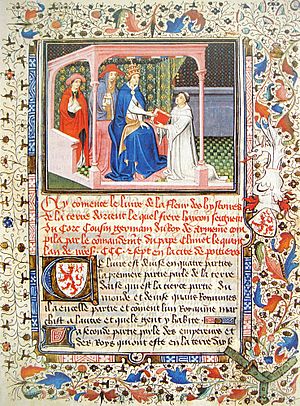Oriental studies facts for kids
Oriental studies is a field of learning that looks at the societies, cultures, languages, and histories of people from the Near East and Far East. These areas are also known as the "Orient." In more recent times, the name "Asian studies" has often taken its place.
Long ago, people in Europe started studying these regions mainly for religious reasons. This interest in religion stayed important for a long time.
Contents
What Are Oriental Studies?
Oriental studies is about understanding a huge part of the world. It covers everything from the Middle East to East Asia. This includes countries like China, Japan, India, and many others.
Exploring Cultures and Languages
People who study this field learn about different cultures. They look at how people live, their traditions, and their art. They also learn many languages, like Arabic, Chinese, and Japanese.
Understanding History and Societies
This field also dives deep into the history of these regions. It explores ancient empires, big changes, and how societies developed. It helps us understand the past and present of billions of people.
Why Did People Start These Studies?
The study of the "Orient" began for many reasons. One main reason was religion, especially for Europeans. They wanted to understand the origins of their own faiths.
Early Travelers and Scholars
Many early scholars and travelers went to these lands. They brought back stories, maps, and knowledge. This helped Europeans learn more about the world beyond their borders.
The Role of Trade and Exploration
Trade routes, like the Silk Road, connected East and West. This led to more interest in these distant lands. Explorers and merchants needed to understand the cultures they met.
How Oriental Studies Changed Over Time
Over the centuries, Oriental studies grew and changed. It became more about understanding the world in a scientific way.
New Discoveries and Museums
In the 1800s, amazing ancient objects were found. These included treasures from Ancient Assyria. When these items were put in new museums, many people became very interested in the "Orient."
Important Meetings and Experts
Experts from different countries started meeting. They shared their knowledge and discoveries. For example, the Second International Congress of Orientalists in London in 1874 brought many scholars together.
Modern Asian Studies
Today, the field is often called "Asian studies." It is still very important for understanding our world. It helps people from different backgrounds learn from each other.
Connecting East and West
Asian studies helps bridge the gap between different parts of the world. It encourages respect and understanding among cultures. It shows how connected we all are.
Images for kids
-
Ancient Assyrian antiquities in the British Museum. In the 19th century, placing spectacular antiquities in new museums brought unusual interest from the public to Oriental studies.
-
Hayton of Corycus remits his report on the Mongols to Pope Clement V in 1307.
-
Matteo Ricci (left) and Xu Guangqi (徐光啟) (right) in the Chinese edition of Euclid's Elements (幾何原本) published in 1607
-
The old building of the Asiatic Society, in Calcutta, founded by William Jones in 1784
-
Experts inspecting the Rosetta Stone during the Second International Congress of Orientalists in London, 1874
-
The Women of Algiers (1834) by Eugène Delacroix is one of the earliest paintings from Western painters in the "Eastern world."
See also
 In Spanish: Estudios Orientales para niños
In Spanish: Estudios Orientales para niños









